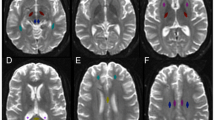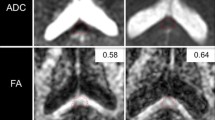Abstract
Background
Apparent diffusion coefficient (ADC) values derived from diffusion-weighted magnetic resonance imaging (MRI) can provide information about traumatic changes not visible in conventional MRI. The ADC values in acute traumatic brain injury (TBI) were measured and correlated with initial severity and outcome scores.
Methods
In this study 22 unselected patients were studied 1 week (mean 7 ± 2 days) after TBI of variable severity. In conventional MRI 7 patients were without visible findings, 15 showed cortical contusions or traumatic axonal injury and 14 healthy subjects served as controls. The ADC values were measured from 46 brain regions away from the visible traumatic changes and compared between the groups. Regional ADC values and the number of abnormal regions were correlated with the Glasgow coma scale (GCS) on arrival in hospital and the Glasgow outcome scale (extended version, GOS-E) at 1 year after injury.
Results
The ADC values of TBI patients with and without visible lesions did not show any differences but both groups differed significantly from the controls in several cortical and deep brain regions. Increased ADC values were common in TBI groups but decreased ADC values were relatively uncommon. The regional ADC values and the number of abnormal regions did not correlate with either GCS or GOS-E scores.
Conclusions
Increased diffusion in normal appearing brain tissue is a common finding 1 week after TBI in patients with and without visible lesions in conventional MRI. More investigations are needed to evaluate how these findings could be used for clinical applications.
Zusammenfassung
Zielsetzung
Die aus der diffusionsgewichteten Magnetresonanztomographie (MRT) abgeleiteten Werte des effektiven Diffusionskoeffizienten ("apparent diffusion coefficient", ADC) können Informationen über traumatisch bedingte Veränderungen geben, die im konventionellen MRT nicht sichtbar werden. Bei Patienten mit akut traumatischen Hirnschäden wurden die ADC-Werte gemessen und mit initialen Schweregraden sowie "outcome scores" in Beziehung gesetzt.
Methoden
Es wurden 22 nichtvorselektierte Patienten eine Woche (Median 7 ± 2 Tage) nach traumatischer Hirnverletzung unterschiedlicher Schweregrade untersucht. Mithilfe des konventionellen MRT zeigten 7 Patienten keine sichtbaren Befunde, 15 Patienten wiesen kortikale Kontusionen oder traumatische axonale Verletzungen auf, und 14 gesunde Patienten wurden als Kontrollen inkludiert. Die ADC-Werte wurden in 46 verschiedenen, von den sichtbaren geschädigten Veränderungen entfernten Hirnbereichen gemessen und zwischen den Gruppen verglichen. Die ADC-Werte örtlich begrenzter Regionen und die Zahl der abnormalen Regionen wurden mit der Glasgow Coma Scale (GCS) bei Ankunft im Krankenhaus sowie ein Jahr nach der Verletzung mit der erweiterten Version der Glasgow Outcome Scale (GOS-E) in Beziehung gesetzt.
Ergebnisse
Die ADC-Werte der Patienten mit traumatischer Hirnverletzung mit und ohne sichtbare Läsionen zeigten keine Unterschiede, aber die Werte beider Gruppen unterschieden sich in verschiedenen kortikalen und tiefen Hirnbereichen signifikant von den Werten der Kontrollgruppe. Höhere ADC-Werte waren in den Gruppen mit traumatischer Hirnverletzung häufiger; verminderte Werte waren relativ selten. Die ADC-Werte örtlich begrenzter Regionen und die Zahl der abnormalen Regionen korrelierten nicht mit den GCS- oder GOS-E-Scores.
Schlussfolgerungen
Diffusionssteigerungen in anscheinend normalem Hirngewebe bilden häufige Befunde eine Woche nach einer traumatischen Hirnverletzung bei Patienten mit und ohne sichtbare Läsionen im konventionellen MRT. Weitere Studien sind nötig, um zu evaluieren, wie diese Ergebnisse klinisch umgesetzt werden können.

Similar content being viewed by others
References
Ahlhelm F, Hagen T, Schneider G, Dorenbeck U, Nabhan A, Reith W. ADC mapping of normal human brain. Med Sci Monit. 2004;10:121–5.
Alsop DC, Murai H, Detre JA, McIntosh TK, Smith DH. Detection of acute pathologic changes following experimental traumatic brain injury using diffusion-weighted magnetic resonance imaging. J Neurotrauma. 1996;13:515–21.
Arfanakis K, Haughton VM, Carew JD, Rogers BP, Dempsey RJ, Meyerand ME. Diffusion tensor MR imaging in diffuse axonal injury. AJNR Am J Neuroradiol. 2002;23:794–802.
Assaf Y, Beit-Yannai E, Shohami E, Berman E, Cohen Y. Diffusion- and T2-weighted MRI of closed-head injury in rats: a time course study and correlation with histology. J Magn Reson Imaging. 1997;15:77–85.
Cellerini M, Konze A, Caracchini G, Santoni M, Dal Pozzo G. Magnetic resonance imaging of cerebral associative white matter bundles employing fast-scan techniques. Acta Anatomica (Basel). 1997;158:215–21.
Curnes JT, Burger PC, Djang WT, Boyko OB. MR imaging of compact white matter pathways. AJNR Am J Neuroradiol. 1988;9:1061–8.
Ebisu T, Naruse S, Horikawa Y, Ueda S, Tanaka C, Uto M, Umeda M, Higuchi T. Discrimination between different types of white matter edema with diffusion-weighted MR imaging. J Magn Reson Imaging. 1993;3:863–8.
Engelter ST, Provenzale JM, Petrella JR, DeLong DM, MacFall JR. The effect of aging on the apparent diffusion coefficient of normal-appearing white matter. AJR Am J Roentgenol. 2000;175:425–30.
Ezaki Y, Tsutsumi K, Morikawa M, Nagata I. Role of diffusion-weighted magnetic resonance imaging in diffuse axonal injury. Acta Radiol. 2006;47:733–40.
Goetz P, Blamire A, Rajagopalan B, Cadoux-Hudson T, Young D, Styles P. Increase in apparent diffusion coefficient in normal appearing white matter following human traumatic brain injury correlates with injury severity. J Neurotrauma. 2004;21:645–54.
Hanstock CC, Faden AI, Bendall MR, Vink R. Diffusion-weighted imaging differentiates ischemic tissue from traumatized tissue. Stroke. 1994;25:843–8.
Helenius J, Soinne L, Perkiö J, Salonen O, Kangasmäki A, Kaste M, Carano RAD, Aronen HJ, Tatlisumak T. Diffusion-weighted MR imaging in normal human brains in various age groups. AJNR Am J Neuroradiol. 2002;23:194–9.
Hergan K, Schaefer PW, Sorensen AG, Gonzalez RG, Huisman TA. Diffusion-weighted MRI in diffuse axonal injury of the brain. Eur J Radiol. 2002;12:2536–41.
Huisman TA, Sorensen AG, Hergan K, Schaefer PW. Diffusion-weighted imaging for the evaluation of diffuse axonal injury in closed head injury. J Comput Assist Tomogr. 2003;27:5–11.
Huisman TA, Schwamm LH, Schaefer PW, Koroshetz WJ, Shetty-Alva N, Ozsunar Y, Wu O, Sorensen AG. Diffusion tensor imaging as potential biomarker of white matter injury in diffuse axonal injury. AJNR Am J Neuroradiol. 2004;25:370–6.
Inglese M, Makani S, Johnson G, Cohen BA, Silver JA, Gonen O, Grossman RI. Diffuse axonal injury in mild traumatic brain injury: a diffusion tensor imaging study. J Neurosurg. 2005;103:298–303.
Ito J, Marmarou A, Barzo P, Fatouros P, Corwin F. Characterization of edema by diffusion-weighted imaging in experimental traumatic brain injury. J Neurosurg. 1996;84:97–103.
Jennett B, Bond M. Assessment of outcome after severe brain damage: a practical scale. Lancet. 1975;I:480–4.
Jennett B, Snoek J, Bond MR, Brooks N. Disability after severe head injury: observations on the use of the Glasgow outcome scale. J Neurol Neurosurg Psychiatry. 1981;44:285–93.
Kinoshita T, Moritani T, Hiwatashi A, Wang HZ, Shrier DA, Numaguchi Y, Westesson P-LA. Conspicuity of diffuse axonal injury lesions on diffusion-weighted MR imaging. Eur J Radiol. 2005;56:5–11.
Levin HS, Williams DH, Eisenberg HM, High Jr WM, Guinto Jr FC. Serial MRI and neurobehavioural findings after mild to moderate closed head injury. J Neurol Neurosurg Psychiatry. 1992;55:255–62.
Liu AY, Maldjian JA, Bagley LJ, Sinson GP, Grossman RI. Traumatic brain injury: diffusion-weighted MR imaging findings. AJNR Am J Neuroradiol. 1999;20:1636–41.
Marmarou A. Pathophysiology of traumatic brain edema: current concepts. Acta Neurochir Suppl. 2003;86:7–10.
Marmarou A, Signoretti S, Aygok G, Fatouros P, Portella G. Traumatic brain edema in diffuse and focal injury: cellular or vasogenic? Acta Neurochir Suppl. 2006;96:24–9.
Marmarou A, Signoretti S, Fatouros PP, Portella G, Aygok GA, Bullock MR. Predominance of cellular edema in traumatic brain swelling in patients with severe head injuries. J Neurosurg. 2006;104:720–30.
Mittl RL, Grossman RI, Hiehle JF, Hurst RW, Kauder DR, Gennarelli TA, Alburger GW. Prevalence of MR evidence of diffuse axonal injury in patients with mild head injury and normal head CT findings. AJNR Am J Neuroradiol. 1994;15:1583–9.
Povlishock JT, Christman CW. The pathobiology of traumatically induced axonal injury in animals and humans: a review of current thoughts. J Neurotrauma. 1995;12:555–64.
Schaefer PW, Buonanno FS, Gonzalez RG, Schwamm LH. Diffusion-weighted imaging discriminates between cytotoxic and vasogenic edema in a patient with eclampsia. Stroke. 1997;28:1082–5.
Schaefer PW, Grant PE, Gonzalez RG. Diffusion-weighted MR imaging of the brain. Radiology. 2000;217:331–45.
Schaefer PW, Huisman TAG, Sorensen AG, Gonzalez RG, Schwamm LH. Diffusion-weighted MR imaging in closed head injury: high correlation with initial Glasgow Coma Scale score and score on modified ranking scale at discharge. Radiology. 2004;233:58–66.
Shanmuganathan K, Gullapalli RP, Stuart E, Mirvis SE, Roys S, Murthy P. Whole-brain apparent diffusion coefficient in traumatic brain injury: correlation with Glasgow Coma Scale score. AJNR Am J Neuroradiol. 2004;25:539–44.
Tench CR, Morgan PS, Wilson M, Blumhardt LD. White matter mapping using diffusion tensor MRI. Magn Reson Med. 2002;47:967–72.
Conflict of Interest Statement
The authors declare that there is no actual or potential conflict of interest in relation to this article.
Author information
Authors and Affiliations
Corresponding author
Rights and permissions
About this article
Cite this article
Brandstack, N., Kurki, T., Hiekkanen, H. et al. Diffusivity of Normal-Appearing Tissue in Acute Traumatic Brain Injury. Clin Neuroradiol 21, 75–82 (2011). https://doi.org/10.1007/s00062-011-0058-5
Received:
Accepted:
Published:
Issue Date:
DOI: https://doi.org/10.1007/s00062-011-0058-5
Keywords
- Traumatic brain injury
- Diffusion weighted MRI
- Magnetic resonance imaging
- Glasgow coma scale
- Glasgow outcome scale




